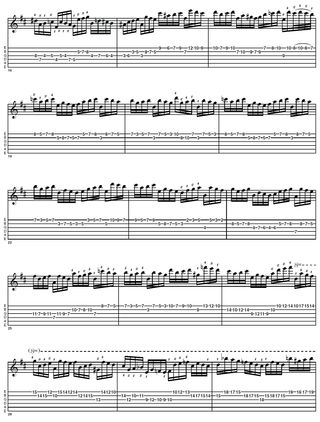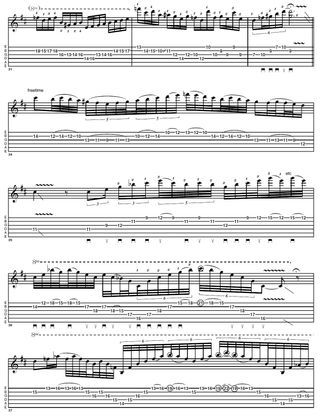Paul Gilbert: how to play Bach's Prelude in D Major

"JS Bach wrote some of the most undeniably beautiful music there is," says Paul Gilbert. "His compositions tend to be more interesting melodically than rhythmically, but I favour melody as a listener, so that suits me fine."
Paul's assertion that Bach focuses more on melody than rhythm is true here, as Prelude in D major is an onslaught of 16th notes using alternate picking. This will help develop your picking accuracy, but the piece will also improve fretting hand dexterity.
If you've ever played or studied Bach before, you'll notice his command of modulation (changing keys) and variation. Although the piece remains in and around the key centre of D major throughout, it also delves into several different keys, so you'll never find yourself staying in the same area of the fretboard for very long.
Whilst this makes it harder to memorise the main bulk of the piece, the melody retains its basic shape al the way through, so you should see a phrasing pattern emerge from the beginning. There are no obvious sections to practise due to the constant semiquaver rhythm, so it may be useful to learn it in digestible 4 and 8 bar portions.
Since it's quite difficult to 'see' the keys as you're travelling through them and therefore latch onto any obvious scale shapes, there'll be a strong element of muscle memory and pure repetition in order to memorise the piece in its entirety.
The freetime ending is loosely based on the original, with an extravagant cadenza solo section that is quite common in classical music. The faster arpeggios are based around diminished 7th shapes that include extended notes fretted with picking hand taps.
This is quite an advanced technique, so if you haven't studied combining tapping with sweep-picking, then improvise with one of the diminished 7th shapes first off.
Get the MusicRadar Newsletter
Want all the hottest music and gear news, reviews, deals, features and more, direct to your inbox? Sign up here.
Last thought: Paul plays this at 125bpm but some pianists play it at around 150bpm. What are you aiming for?
Audio example:
Next page: high-quality tab
Tab part 1

(Click tab to enlarge)
[Bar 1] The gigantic stretch from 10th fret to 17th fret is necessary for the sake of smoothness and also to avoid any awkward position shifts. Keep your first finger anchored to the 10th fret for the whole of this first bar, and remember to begin with an upstroke.
[Bars 4, 23] The start of beat 3 is typical of the many position shifts that are required throughout this piece in order to stop your fingers twisting into impossible shapes. You'll notice quite a lot of unusual lateral (sideways) movement is required, especially with the first finger.
Next page: tab part 2
Tab part 2

(Click tab to enlarge)
[Bars 12, 16] There's a few options to execute this same fret, different string move. One is to use a different finger (shown here with the second and first fingers) or to use the first finger for both using a finger roll. Watch out for note bleed, though!
[Bars 27-28] There are some awkward fingerings and position shifts to contend with here. Always look ahead rather than what position you happen to be in now, as that will usually dictate the most obvious fingering to use.
Next page: tab part 3
Tab part 3

(Click tab to enlarge)
[Bars 34-35] The start of Paul's cadenza should have a loose, 'play very quickly' feel, so don't pay too much attention to the odd quintuplet groupings. Bar 35 sees the start of some fast sweep-picked diminished arpeggios so there are some suggested fingerings and pick directions.
[Bars 36-37] Paul improvises around C# dim and B dim arpeggios here (basically the same sweep pattern two frets apart). You should hopefully notice the identifiable three-fingered shape that is common to the adjacent strings which will make it easier to zip around at high speed.
Next page: tab part 4
Tab part 4

(Click tab to enlarge)
[Bar 40] Paul's alternate picking technique when crossing strings is quite superb, as in this example (down pick the second string, and up pick the first string).
If you're struggling to get up to speed, you may prefer to use hybrid picking (down pick the second string, second finger picks the first string) and unlike elsewhere, you can let these notes ring into each other.










